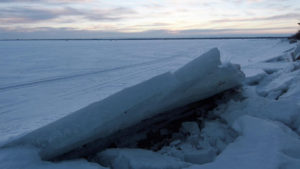An ice Shove by any name …
Ice Shove, Ice Heave, Ice Surge, or Ice Tsunami, no matter what you call it, they all refer to the same natural phenomena.
First, you need to understand how a pressure ridge forms so please follow this link to this article: https://wisconsinpws.com/ice-pressure-ridge/
The pressure ridge is the usual predecessor of an ice shove.
Having read the article, we need to talk very briefly about the terminology of a pressure ridge.
From the previous article, you can see the “rubble” forming the “Keel” of the pressure ridge. After the Keel forms the “Sail” forms above the surface of the ice. When the next strong wind comes along the “sail” will begin pushing against the shore ice. Eventually, some of it will begin to climb over the shore ice and form an ice shove.
When do Ice shoves typically occur?
Ice shoves normally happen during a spell of warmer weather. However, the shove may happen anytime the ice is weakened and then exposed to strong winds.
A shove is more likely to occur the longer the ice is exposed to the winds. The most common time of the year to see this phenomenon is late February and into March although January is not unheard of if a thaw occurs.
The shove occurs when strong winds rapidly push free-floating ice towards or along the shore. Strong winds over time drive areas of ice onshore. As these moving masses of ice travel towards the shoreline, they begin piling up when they encounter resistance from the shoreline or other obstacles. The resulting shove can reach heights of up to 50 feet.
What will an ice shove do to my property?
An ice shove has tremendous power and have been known to push houses off their foundations and uproot large trees and crush seawalls.
Shoreline barriers like trees, seawalls and shallow cliffs do not present any challenge to an ice shove. The ice simply piles up until it flows over the object or simply crushes it. The shove could continue on its journey as long as the winds continue. This depends on the force of the wind and the strength of the ice. One or two properties may be affected while the adjoining properties see no movement at all.
How do I protect my property?
There is only one thing that you can do – move your waterfront equipment far enough away that the ice normally will not get to it. In doubt? Watch what your neighbors do in Fall. If they have been there for any length of time they know how far back to go to protect their equipment in a normal year. Our crews remove equipment in Fall and have a good idea where it has to go also.
What does Pier and Waterfront Solutions do to protect equipment?
With little or no shoreline, here’s an example of what PWS does to prevent damage to your equipment. The lift and dock had to be raised to the top of a ledge to avoid damage.
How big are Ice Shoves?
Ice Shoves sometimes affect a small area of shoreline all the way up to vast distances. This ice shove affected just one property while the neighbors had no damage.
For more information check this video to see an actual ice shove in action: https://www.youtube.com/watch?v=Pf5pWz7uRt4
Reminder
Pier & Waterfront Solutions specializes in ShoreMaster docks, lifts, and accessories both residential and commercial. We service the rest.
PWS is located in the center of Door County at 7325 St Hwy 57. Located 1 mile North of County MM (Hwy 42) and South of Sturgeon Bay at the intersection of Idlewild Road. Our staff is ready to help you anytime.
Want us to address a dock or boat lift topic for you? Feel free to give us a call.
Call Jerry at 920-493-4404 or email him at Jerry@wisconsinpws.com for more information.















